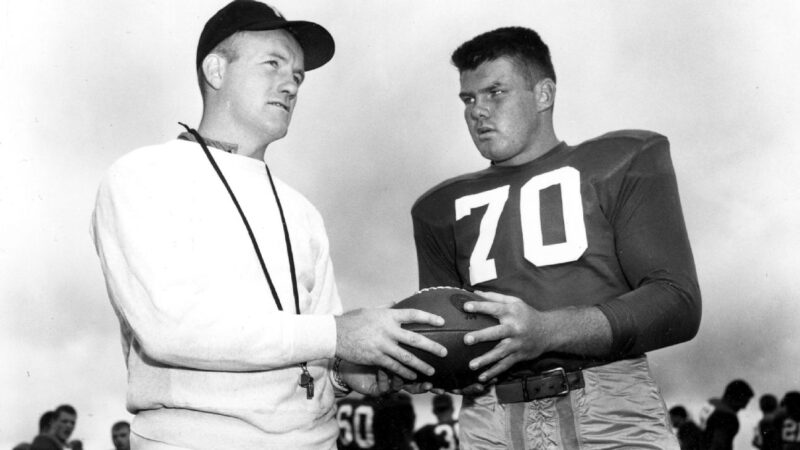Terry Brennan, who played halfback for the Notre Dame Fighting Irish football team in the late 1940s and early 1950s, died on April 29 at 93.
Terry Brennan, star halfback who later coached Notre Dame Fighting Irish football team, dies at 93. He was a player and coach for the Fighting Irish from 1946 to 1959.
INDIA, SOUTH BEND — Terry Brennan, a standout halfback on three undefeated Notre Dame teams who was regarded as a wunderkind when he took over as Irish coach from Frank Leahy at the age of 25, has passed away. He was 93 years old when he died.
His death was confirmed by the school on Wednesday. Brennan died on Tuesday, according to the Skokie, Illinois funeral home in charge of the preparations. He had formerly resided in Wilmette.
Brennan was the Irish’s leading receiver and scorer when they won back-to-back national titles in 1946 (8-0) and 1947 (9-0), as well as going 9-0-1 and finishing second in 1948. John Lujack and Leon Hart, both Heisman Trophy winners, were among his teammates.
Brennan was a part of some of Notre Dame’s most memorable games, both as a player and as a coach.
Brennan made a crucial interception in a 0-0 draw between the second-ranked Irish and No. 1 Army at Yankee Stadium in 1946, nicknamed “The Game of the Century.”
Army marched to Notre Dame’s 12 yard line, but Brennan intercepted a ball at the 5. On the following play, he ran 22 yards for Notre Dame’s longest run.
In a 2010 interview, he stated, “It turned out to be sort of a boring game of the century.”
Terry Brennan, left, was named head coach of Notre Dame at the age of 25, shocking the collegiate football world. He ended with a 32-18 record. Photo courtesy of AP
Both teams were undefeated throughout the regular season and did not compete in any bowl games. In the final AP poll, Notre Dame was chosen No. 1 while Army was ranked No. 2.
He said, “Most of us were young men who didn’t understand how huge it was until 10 or 20 years later.”
In 1957, he coached the Irish to a 7-0 victory over Oklahoma, ending the Sooners’ record-setting 47-game winning streak.
Brennan was selected by the NFL when his playing career ended, but instead opted to teach at Mount Carmel High School in Chicago while studying law at DePaul University. Brennan was hired to coach the freshman team at Notre Dame after leading Mount Carmel to city championships in 1951, 1952, and 1953.
Brennan was elevated to head coach the following season, shocking the collegiate football world. In 11 seasons at Notre Dame, Leahy won four national championships before retiring due to health issues.
Brennan got off to a good start, with Notre Dame going 9-1 and No. 4 in 1954 and 8-2 and No. 9 the following year. Despite boasting Heisman Trophy-winning quarterback Paul Hornung, the Irish went 2-8 in 1956, losing 47-14 to Michigan State and 40-0 to Oklahoma in South Bend in the team’s most lopsided defeat at Notre Dame Stadium.
As a consequence, the school’s sports faculty board recommended that Brennan be dismissed. However, the university’s president, The Rev. Theodore Hesburgh, decided to bring Brennan back.
The next season, Notre Dame went 7-3, ranking No. 10 and buoyed by a huge win over Oklahoma.
When the Irish were blown out by Oklahoma in 1956, Brennan admitted in 2007 that he took some risks that didn’t pay off. In 1957, he was more confidence in his team’s abilities, so he called the game more cautiously, and the defense performed well.
“You never play a flawless game,” he added, “but I don’t believe the players made many errors.” “The point was that there were relatively few, if any.”
Oklahoma fans were stunned, according to Brennan.
He described the stillness as “deafening.”
Brennan was dismissed four days before Christmas in 1958, four days after the Irish finished 6-4. Many people were outraged by the decision, not just because of the timing, but also because supporters said Brennan was stepping down because the school had cut down on scholarships as it increased academic requirements.
Brennan completed the season with a 32-18 record and a.640 winning percentage. Joe Kuharich, a former Notre Dame player with a 17-23 record in four seasons, was named his successor.
Brennan hasn’t coached football since then. For the Cincinnati Reds’ 1959 spring training, he worked as a player fitness coach. He resided in suburban Chicago and worked in finance and investment for many years.
Kel, Brennan’s wife, died before he did. Four sons, two daughters, 25 grandkids, and 32 great-grandchildren survive him.

